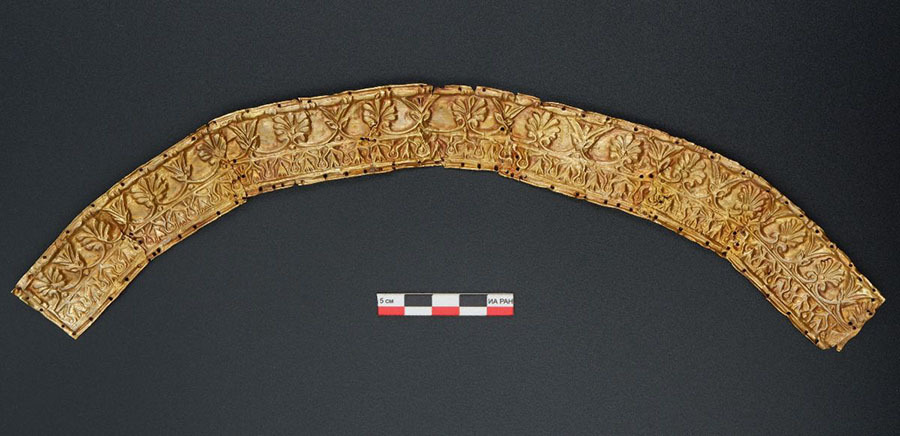Russian scientists from the Institute of Archeology of the Russian Academy of Sciences discovered the burial of the Scythian Amazon in a ceremonial headdress made of precious metals. The burial dates from the second half of the 4th century BC. e. The find was made during the study of the burial mound Damsel V in the Ostrogozhsky district of the Voronezh region. Archaeological work in this place has been ongoing since 2010.
Researchers note that for the first time they managed to find a ceremonial headdress in full safety in the Middle Don.
“Calaf found is a unique find. This is the first whole headdress on the monuments of the Scythian time, found on the Middle Don, and it is found in situ, on the spot, on the skull. Of course, such hats were previously found in the famous rich mounds of Scythia, but only a few were discovered by archaeologists: more often they were found first by peasants, then they were seized by policemen, landowners, and finds, when they reached the experts, passed through many hands, and therefore it is not known how much they are preserved, ”said the head of the Don expedition Valery Gulyaev at a meeting of the Scientific Council of the Institute of Archeology of the Russian Academy of Sciences.
- General view of the burial
- © Institute of Archeology RAS
According to archaeologists, four women of different ages were buried simultaneously in the mound. The burials of two of them - a teenage girl and a young woman - were badly damaged by a robbery committed in ancient times.
However, the other two skeletons were untouched. One of them belonged to a young woman who was buried in the pose of a rider. A bronze mirror and two spears were placed near it. On the skifian’s left hand was a bracelet made of glass beads, and two vessels were in the legs: a molded incense burner and black-lacquered one-handed kanfar, made in the second quarter of the 4th century BC.
The second buried woman was 45-50 years old, which for those times was considered a fairly respectable age. She was buried in a ceremonial female headdress - calaf, from which preserved plates decorated with floral ornaments, and rims with pendants in the form of amphorae. Studies have shown that jewelry was made of an alloy in which approximately 65-70% is gold.
Near the head of the older woman was an iron knife, as well as arrowheads of a rather rare type: petiolate with a forked end. According to scientists, these findings, as well as numerous details of weapons and horse harness, allow us to conclude that "Amazons" - female warriors - were buried in the mound. Similar warriors existed in the Scythian era among Iranian-speaking nomadic and semi-nomadic tribes of Eastern Europe. They probably guarded property and homes when men went on military campaigns.
- Headdress plate (stelgid)
- © Institute of Archeology RAS
“A little more than two dozen such hats were found, and all of them were found in the“ royal ”, or in the very rich mounds of the steppe zone of Scythia. We first found such a piece of clothing in the mounds of the forest-steppe zone, and what is especially interesting is that the piece was first discovered in the Amazon’s burial, ”Gulyaev said.
Now scientists have to find out why the women died.
“We are faced with a riddle: we have two women in their prime, one teenager and one woman, quite elderly for the Scythian time. It is not clear how they could all perish in an instant? They have no evidence of bone injuries. Two women whose bones were scattered have signs of tuberculosis, brucellosis, but they do not die from these diseases at the same time. Therefore, we cannot yet understand what the cause of death was, and why four women of different ages were buried at the same time, ”said Gulyaev.

